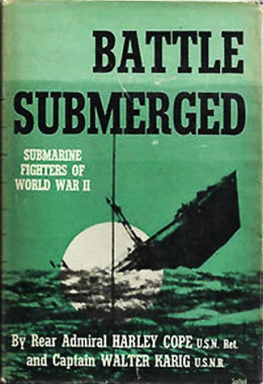Harley Cope - Battle Submerged
Here you can read online Harley Cope - Battle Submerged full text of the book (entire story) in english for free. Download pdf and epub, get meaning, cover and reviews about this ebook. year: 2013, genre: Non-fiction. Description of the work, (preface) as well as reviews are available. Best literature library LitArk.com created for fans of good reading and offers a wide selection of genres:
Romance novel
Science fiction
Adventure
Detective
Science
History
Home and family
Prose
Art
Politics
Computer
Non-fiction
Religion
Business
Children
Humor
Choose a favorite category and find really read worthwhile books. Enjoy immersion in the world of imagination, feel the emotions of the characters or learn something new for yourself, make an fascinating discovery.
- Book:Battle Submerged
- Author:
- Genre:
- Year:2013
- Rating:4 / 5
- Favourites:Add to favourites
- Your mark:
- 80
- 1
- 2
- 3
- 4
- 5
Battle Submerged: summary, description and annotation
We offer to read an annotation, description, summary or preface (depends on what the author of the book "Battle Submerged" wrote himself). If you haven't found the necessary information about the book — write in the comments, we will try to find it.
Battle Submerged — read online for free the complete book (whole text) full work
Below is the text of the book, divided by pages. System saving the place of the last page read, allows you to conveniently read the book "Battle Submerged" online for free, without having to search again every time where you left off. Put a bookmark, and you can go to the page where you finished reading at any time.
Font size:
Interval:
Bookmark:


Jerry eBooks
No copyright  2013 by Jerry eBooks
2013 by Jerry eBooks
No rights reserved. All parts of this book may be reproduced in any form and by any means for any purpose without any prior written consent of anyone.
COPYRIGHT 1951, BY W. W. NORTON & COMPANY, INC.
FIRST EDITION
PUBLISHED IN THE UNITED STATES OF AMERICA
FOR THE PUBLISHERS BY THE VAIL-BALLOU PRESS, INC.
GRATEFULLY DEDICATED TO THE OFFICERS AND MEN
of the SILENT SERVICE
THE PRIMARY purpose of this book is to describe the extraordinary versatility of what will probably be the most important fighting craft in the next warthe submarines. The method the authors have chosen is to relate each of the war missions that the submarines of the United States Navy were sent out to perform, in the narratives of as many ships. Any one submarine can do, and in the last war did do, virtually everything herein described.
The secondary purpose of the book is to demonstrate that even in this age of gadgetry and electronics, the sea is still the source of extraordinary adventure that it was in the days of sail and galleys.
This is not a history, or even intended as a preface to the history, of the United States submarine in World War II. Consequently the authors must deeply regret the conspicuous omissions from this volume, but no apologies are offered because none are expected by men of the stripe of Joe Willingham, Barney Sieglaff, Creed Burlingame, Slade Cutter, Reuben Whitaker, George Grider, Johnny Coy, Burt Klakring which is to say, every sub skipper who creased enemy waters with torpedoes. In the editorial judgment they exercised in selecting the one episode out of a hundred like it to describe a particular function of the submarine, the authors had only one motive, to do the most comprehensive job possible for the readers benefit, and especially for the reader who never saw a submarine and wouldnt ride in one for the traditional, if devalued, million dollars.
Debts are inadequately acknowledged to Admiral Louis Denfeld who, as Chief of Naval Operations, authorized use of war diaries and related operational reports to insure the accuracy of these tales of the Silent Service; and to Captain Charles F. Erck, Captain William D. Irvin and Captain Lewis S. Parks, who gave indispensable help in expanding the too meager accounts their too modest colleagues recorded in war diaries and official reports.
HARLEY COPE
WALTER KARIG

THE SUBMARINE is essentially an American innovation, but in its development the United States has always lagged behind her sister maritime nations. During the War for Independence the infant United States had initiated submarine warfare with David Bushnells hand-propelled but impotent Turtle. Ironically, perhaps, the first warship in history to be sunk in combat by a submarine was the USS Housatonic destroyed by the primitive hand-operated Confederate submarine Hunley on February 17, 1864.
Other nationsFrance, Italy and Germanyhad equipped their navies with submarines well before the parent country commissioned the first of John P. Hollands underwater torpedo boats on April 11, 1900. At the end of World War II we were still trying to catch up with our late enemies except in one thing: personnel. We may not have had the best submarines in the world, but by the record we had the worlds best submariners.
A great difference existed between the types of boats that fought World War I and World War II, but it was the sort of difference shared with the automobiles and airplanes of that span of years. Refinements and improvements had been added, but the fundamental principles remained unchanged. Like the Model T of 1918 and the streamlined job of 1941 the plodding L-boats of World War I and the history-making Barb of 1945 were brothers under the skin. They both dove by flooding ballast tanks and torpedo tubes, still ejected 21-inch torpedoes. Diesel engines continued to drive them on the surface while the same type of electric motors, taking their energy from a nest of large storage batteries, were used submerged; periscopes still observed the targets.
The difference even between the first Holland submarine and the best we had in operation against Japan was evolutionary. Only now are we entering the stage of revolutionary change, the true submarine that can cruise around the world without having to surface to breathe or charge batteries.
When its size is compared with the wallop it packs, the submarine is unquestionably the most compact man-of-war in existence, and consequently the most crowded. The boat is no place for anybody who must have plenty of elbow room. Its bulkheads are so covered with dials, tubes, coils and gauges there is small room for pinups, but not a single piece of equipment aboard is dispensable to its best operation.
The submarine of World War II, already obsolescent, was a little over 300 feet long, with a displacement of 1,500 tons, a surface speed of twenty knots or a little better and a maximum submerged speed of ten knots. (Our newer subs will not change much in the single factor of external dimension.)
Its maximum armament consisted of six torpedo tubes forward, four aft, and twenty-four torpedoes to shoot from them. One full torpedo salvo banged out three tons of explosive, enough to sink the largest warship afloat.
The deck gun grew from 3-inch to 4-inch, and finally graduated to a 5-incher. The original .50 caliber machine gun was latterly augmented by 20-millimeter and 40-millimeter guns. In the new submarines the deck guns are disappearing. Whats the use for such guns on a submarine that never exposes its decks in combat?
The compartmentation in the submarine with which this book is concerned hadnt changed much between wars. In the bow is the forward torpedo room, then next in line going aft are the forward battery room, control room, after battery, forward and after engine rooms, maneuvering room, and after torpedo room. Forward, of course, is navy language for up front, and after means toward the stern or rear.
In the forward battery are the wardroom (on any ship the combined living room-dining room) and the officers quarters. The control room and conning tower are the nerve center of the boat. Here the diving, steering, navigation, fire control, and every other control aboard are located. In the after battery are the galley (kitchen) and crews quarters. Throughout the boat, tucked in this and that corner, under control boards, in the overhead, are located units which provide the submarine with its air conditioning, refrigerating, fresh water, high-pressure air bottles, radio and radar. In fact, so many things are packed away in a sub that a catalog of all it contains in such relatively small space would be read with disbelief.
The hull resembles a huge Perfecto cigar in shape, internally divided lengthwise in approximate halves. The lower half of the hull is subdivided into various tanks: fuel, water, storage batteries, and the diving or ballast tanks. Two hundred fifty-two large battery cells, each one weighing close to a ton, are the source of electric power. The batteries are kept charged by the Diesel generators when the boat is on the surface.
Next pageFont size:
Interval:
Bookmark:
Similar books «Battle Submerged»
Look at similar books to Battle Submerged. We have selected literature similar in name and meaning in the hope of providing readers with more options to find new, interesting, not yet read works.
Discussion, reviews of the book Battle Submerged and just readers' own opinions. Leave your comments, write what you think about the work, its meaning or the main characters. Specify what exactly you liked and what you didn't like, and why you think so.












